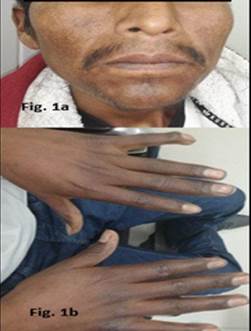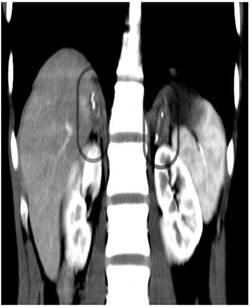Servicios Personalizados
Revista
Articulo
Indicadores
-
 Citado por SciELO
Citado por SciELO
Links relacionados
-
 Similares en
SciELO
Similares en
SciELO
Compartir
Revista de la Facultad de Medicina Humana
versión impresa ISSN 1814-5469versión On-line ISSN 2308-0531
Rev. Fac. Med. Hum. vol.20 no.4 Lima oct./dic 2020
http://dx.doi.org/10.25176/rfmh.v20i4.2953
Clinical case
Tomographic diagnosis of primary adrenal tuberculosis in Addison's disease at altitude. Case Report.
1Universidad Peruana Los Andes. Facultad de Medicina Humana. Catedra de Medicina Interna II. Huancayo - Perú.
2Sociedad Científica de Estudiantes de Medicina Los Andes (SOCIEMLA). Huancayo-Perú.
3Ministerio de Salud (Minsa), Hospital Nacional Daniel Alcides Carrión, Servicio de Medicina Interna. Huancayo Perú.
4Seguro Social de Salud (EsSalud), Hospital Nacional Ramiro Priale Priale. Servicio de Cuidados Intensivos e Intermedios. Huancayo Perú.
We report the case of a 23-year-old man, natural and high-altitude resident, with hyperpigmentation, asthenia, fatigue, nausea, vomiting, weight loss, abdominal pain, hyporexia, and hypotension, with decreased cortisol dosage and elevated ACTH. Normal chest X-ray, negative sputum and urine smear, negative TB LAM antigen. The contrast-enhanced computed tomography of the abdomen shows an increase in dimensions and small calcifications in both adrenal glands, suggesting a specific granulomatous infiltration type. In endemic tuberculosis areas such as Peru; In the absence of adrenal biopsy, it can be used early as a diagnostic alternative to tomography to rule out adrenal involvement. In conclusion, this report has described how tomography can be used as an alternative diagnostic method in hospitals where it is not feasible to perform a quick biopsy.
INTRODUCTION
Addison's disease (AD) is characterized by a decrease in steroidogenic hormones, mineralocorticoids, glucocorticoids, and androgens. The clinical manifestations in a chronic patient are asthenia, abdominal pain, nausea, vomiting, hypoglycemia, hypotension, among others, and it is accompanied by skin hyperpigmentation due to the increase in plasma ACTH. The diagnosis is made by clinical suspicion and demonstrating a low cortisol production (<3 ug/dl)1. It has an incidence of 0.83 per 100,000, a prevalence of 4-6 per 100,000 per year. It is 2 to 3 times more common in women. The most frequent etiology is idiopathic with 70%, tuberculosis (TB) represents 7-20% of cases2,3. In developing countries, TB has a higher prevalence, represented by 47% in India and 34% in South Africa.4,5
Adrenal tuberculosis is the affection of the adrenal glands caused by Mycobacterium tuberculosis. The aetiological diagnosis of certainty is confirmed with the biopsy of the gland. It is estimated that between 19 and 43% of the world's population is infected with TB. Tuberculous adrenalitis only develops in 0.3% to 5% of patients with TB3. There are no epidemiological studies in our country and less in altitude due to the lack of published series.6.
Findings on computerized axial tomography (CT) can support the clinical-etiological diagnosis of AD. In infection by Mycobacterium tuberculosis, an increase in the size of the adrenal gland is evidenced; initially to a gland and then bilateral with the presence of microcalcifications and granulomatous infiltration.7,8
En-Sen Ma et al. in 2007 showed in 19 patients (38 glands) that tomography and laboratory and clinical tests have high specificity in the diagnosis of TB associated with AD9. García Romero M, et al. public in 2010, a clinical case where tomography was used as a diagnostic aid to detect adrenal tuberculosis, then confirmed with a biopsy of a patient with AD10. Alemparte Pardavila E, et al. public in 2005a clinical case of adrenal tuberculosis that could not be confirmed with computed tomography.(11
The early diagnosis of adrenal tuberculosis is important for initiating treatment and improving these patients’ prognosis. We present a case where CT was used as a diagnostic support method for adrenal insufficiency due to primary tuberculosis. Our objective is to describe how tomography can be used as an alternative diagnostic method in hospitals where it is not feasible to quickly perform a biopsy and detect if our patient has characteristics different from those described at sea level.
CASE REPORT
A 23-year-old man, natural and resident of the altitude, is admitted by emergency to the hospital in Huancayo - Peru (3,250 meters of altitude, Barometric Pressure: 550 mmHg). He denies having contact with chronic coughs or patients with TB. For 6 months, he has had hyperpigmentation. Upon admission, he presented asthenia, fatigue, nausea, vomiting, weight loss, abdominal pain, and hyporexia. In the physical examination, generalized hyperpigmentation of the skin and mucosa of the oral cavity is visualized, hypotension (blood pressure 98/68 mmHg), heart rate 88 per minute, and respiratory rate of 20 are detected (Figure 1). Addison's disease is confirmed with a decreased cortisol dose (0.5 µg / dl), elevated ACTH. Since TB is the main cause of adrenal insufficiency in developing countries, this possibility is studied, for which reason it is requested: chest x-ray without alterations. BK in sputum and urine negative and TB LAM antigen negative. Faced with negative tests for TB and there are tomographic characteristics that may bring us closer to the diagnosis of adrenal insufficiency due to TB, a CT scan of the abdomen with contrast is requested, which describes an increase in dimensions, small calcifications in both adrenal glands suggestive of granulomatous infiltration of a specific type. (Figure 2)
As part of the differential diagnosis, infection by cryptococcus, syphilis, hepatitis B, and HIV are ruled out using cryptococcal antigen, rapid plasma reaginin, surface antigen together with hepatitis B core and rapid negative HIV test respectively. Treatment for adrenal insufficiency with glucocorticoids is started; 40 mg prednisone in the morning and 20 mg in the afternoon. Antituberculous treatment was started (negative BK sensitive scheme) Isoniazid 5mg / kg, rifampicin 10mg / kg, ethambutol 20mg / kg, pyrazinamide 25mg / kg. The patient progressed favorably upon discharge.
DISCUSSION
Addison's disease’s main manifestations are hyperpigmentation in the palmar crease, knuckles, and oral mucosa. Gastrointestinal disorders associated with hyponatremia, and hypercalcemia. In our case, hyperpigmentation could be observed. The areas also described on the face, abdomen, and lower limbs are associated with gastrointestinal problems, without showing alterations in their electrolytes.5,12,13
Although autoimmune adrenalitis is described worldwide as the most common cause of adrenal insufficiency, TB is the main cause of an infectious type in developing countries, so it is mandatory to rule it out. The diagnosis of adrenal tuberculosis using tomography in association with other laboratory tests confirmed with the biopsy result has been described. However, in our report, the auxiliary tests cannot confirm the presence of primary pulmonary or adrenal tuberculosis, being the tomography the test that supported our diagnosis.10,11,9. The main limitation in the present case was the inability to perform an early adrenal gland biopsy, so the tomography was performed.
In the absence of antecedents of a report on the altitude that associates adrenal insufficiency with TB, we wanted to compare our findings with those reported at sea level, finding no differences.
In TB endemic areas such as Peru, we recommend that an early tomography be used as a diagnostic alternative to rule out adrenal involvement in the absence of an adrenal biopsy. We also propose the execution of an analytical observational study to confirm our hypothesis of considering tomography as the first-line method for diagnosing adrenal tuberculosis in cases of adrenal insufficiency in the absence of a biopsy. In conclusion, this report has described how tomography can be used as an alternative diagnostic method in hospitals where it is not feasible to perform a quick biopsy.
REFERENCES
1. Fernández Rodríguez E, Bernabeu L, Guillín C, Casanueva F. Enfermedades de las glándulas adrenales Insuficiencia suprarrenal primaria. Medicine. 2016; 12(14):775-80. [ Links ]
2. Candel-González F, Matesanz David M, Candel Monserrate I. Insuficiencia corticosuprarrenal primaria. Enfermedad de Addison. Anales de Medicina Interna. 2001; 18(9):492-498. [ Links ]
3. Cabrerizo-García J, Zalba-Etayo B, Domene Moros R. Adrenalitis tuberculosa. Revista Médica de Chile. 2012; 140(8):1087-1088 [ Links ]
4. Ten S, New M, Maclaren N. Clinical review 130: Addison's disease. J Clin Endocrinol Metabol 2001; 86(7):2909-2922 [ Links ]
5. Soule S. Addison's disease in Africa: a teaching hospital experience. Clin Endocrinol (Oxf) 1999; 50(1):115-120. [ Links ]
6. Coras N, Somocurcio J, Aguilar C. Tuberculosis primaria de la glándula suprarrenal: comunicación de dos casos. Anales de la Facultad de Medicina. 2013; 74(3):221-6. [ Links ]
7. Pila-Pérez R, Pila-Peláez R, Guerra Rodríguez C, Vázquez Pérez L, Pérez Marrero C. Tuberculosis suprarrenal. A propósito de una observación. AMC 2000; 4(1):1-2. [ Links ]
8. Sun ZH, Nomura K, Toraya S, Ujihara M, Horiba N, Suda T, Tsushima T, Demura H, Kono A. Clinical significance of adrenal computed tomography in Addison's disease. Endocrinol Jpn. 1992 Dec;39(6):563-9. [ Links ]
9. En-Sen Ma, Zhi-Gang Yang, Yuan Li, Ying-Kun Guo, Yu-Ping Deng, Xiao-Chun Zhang. Tuberculous Addison's disease: Morphological and quantitative evaluation with multidetector-row CT. European Journal of Radiology 2007; 62(3):352-358 [ Links ]
10. García-Romero M, Arenas R, Arellano-Bernal R, Rull J. Enfermedad de Addison secundaria a tuberculosis suprarrenal. Un caso con hiperpigmentación cutánea ungueal y de mucosas. Med Int Mex 2010; 26(3):281-285 [ Links ]
11. Alemparte-Pardavila E, Martínez-Melgar J, Piñeiro-Sande N, Castellano-Canda P, Rodríguez-García J. Enfermedad de Addison: el reto de un diagnóstico precoz. An. Med. Interna (Madrid) 2005; 22(7):332-334. [ Links ]
12. Arlt W, Allolio B. Adrenal insufficiency. Lancet 2003; 361(9372):1881-1893. [ Links ]
13. Atamari-Anahui N, Montoya-Lizárraga M. Insuficiencia suprarrenal primaria (enfermedad de Addison) secundaria a tuberculosis suprarrenal: Reporte de un caso. Revista Cuerpo Médico HNAAA 2014; 7(1):33-35 [ Links ]
Received: May 14, 2020; Accepted: July 16, 2020











 texto en
texto en 




